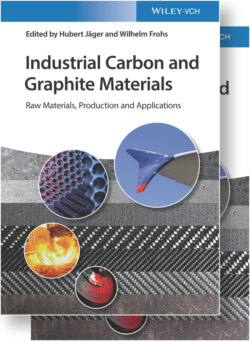Читать книгу Industrial Carbon and Graphite Materials - Группа авторов - Страница 280
6.1.2.3.1.3 Flexicoking
ОглавлениеThe flexicoking process combines fluid coking with gasification. A flow scheme of flexicoking is shown in Figure 6.1.2.7. Flexicoking is a residue conversion process that combines coke gasification with conventional fluid coking. Three fluidized beds are in operation at the reactor, heater, and gasifier. Shrinking markets for the coke obtained in substantial amounts as by‐product of delayed coking and fluid coking due to restrictions of sulfur emission encouraged the development of the flexicoking process. In flexicoking most of the coke produced is converted to low‐Btu fuel gas in the gasification reactor. This fuel gas can be desulfurized to approximately the equivalent of a 0.25 wt% sulfur fuel oil. Thus, particularly for feed stocks with a high metal and sulfur content, flexicoking can be an advantage, because it produces marketable liquid products plus fuel gas.
Thermal conversion of the feed takes place in the reactor (a) where the feed is atomized through a series of nozzles into a bed of fluidized coke particles. Coke occurs in a thin film on the fluidized particles within the bed. The coke bed is fluidized by the product vapors and by stripping steam injected at the bottom of the reactor. Typical bed temperatures are 510–540 °C. Vapor products from the conversion reactions in the bed go overhead through cyclone separators, which remove most of the entrained coke and return it to the reactor bed. The cyclone outlets discharge the vapor product directly into a scrubber (b) where heavy liquid is used to scrub out the remaining coke dust and condense unconverted high‐boiling fractions. The dust laden liquid is recycled as “slurry cycle” to the reactor with the feed. The scrubbed vapor is sent to the coker fractionator, where the stream is split into gas, naphtha, distillate, and heavy gas oil streams. Coke produced in the reactor is gasified by steam and air in the gasifier (d), which operates at a bed temperature of approximately 955 °C. The heater (c) serves as a surge vessel and transfers heat from the gasifier overhead gas to coke, which in turn supplies the heat of reaction in the reactor. The heater bed temperature is approximately 610 °C. Coke is continuously circulated between the three vessels to transfer heat and maintain vessel inventories. Heat for the endothermic cracking reactions in the reactor is supplied by coke combustion in the gasifier. In addition to the coke fines recovered from the heater overhead gas, product coke can be withdrawn from the heater bed. All liquid or gas streams require further treating [25]. The low net coke product is very fine and has very high metals content. It has been used as fuel coke with the resultant high vanadium ash suitable for metals recovery.
Figure 6.1.2.7 Flow sheet of flexicoking. (a) Reactor. (b) Scrubber. (c) Heater. (d) Gasifier. (e) Cyclones. (f) Airblower.
